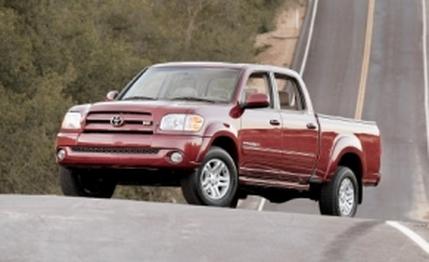
 Short Take Road Test
Short Take Road Test
In the past, Toyota has seemed just a tad reticent about confronting the domestic full-size pickup-truck market. Witness the T-100. What was that supposed to be? Then came the Tundra, a perfectly wonderful device for people who mostly didn't really see themselves in a big ol' pickup truck.
With the recent introduction of the Tundra Double Cab, all that has changed. Flaunting a 140.5-inch wheelbase and overall length of 230.1 inches, the grown-up Tundra is almost four inches longer than the latest Ford F-150 SuperCrew. Moreover, the extra length accommodates a 74.3-inch-long load bed, and that's at least seven inches longer than the bed in the F-150 SuperCrew or Nissan Titan crew cab.
These are not the only places where size counts. The Double Cab offers rear legroom of 37.5 inches, which is more than in competing Dodge or Ford models, and it has a rear seatback angle of 24 degrees. The rivals typically have only 18-to-21 degrees of recline for rear-seat passengers to exploit.
Of course, engine size matters, too, in the pickup pissing contest, and here the Toyota has to rely on a 3.4-liter V-6 in the base models and on its only truck-compatible V-8, the 4.7-liter DOHC 32-valve i-Force unit found in other Tundras as well as in Toyota and Lexus SUVs. It's a good engine, that's for sure, but in the Double Cab 4x4 it is being asked to pull more than 5000 pounds of pickup truck with 240 horsepower and 315 pound-feet of torque.
In so doing, the i-Force engine tows the Double Cab to 60 mph in 9.2 seconds. That's slower than many of the obvious competitors, and well off the 6.9-second dash of a . Still, the Tundra doesn't feel slow on the road, where its sophisticated engine and carefully managed transmission provide the usual suave propulsion we've come to expect from these trucks.Nissan Titan 5.6SE crew cab ( C/D, November)
Our test Tundra was a 4x4 model, with Touch Select two- or four-wheel drive and low range, and although the extra driveline weight found in 4x4 trucks made itself felt as slightly more ponderous body motions, the Toyota was nonetheless supple and quiet in operation.
Toyota engineers report that the Double Cab has an all-new frame, necessitated by the company's desire to meet its size and load targets. The Tundra Double Cab we tested can tow 6500 pounds, but that rating varies from 4800 to 7200 throughout the range of cabs and drivetrains-as do the payload ceilings-so consult the dealer's chart if you plan to carry exceptional loads.
One thing is for sure, this is a big truck. Even with the mellifluous engine noises, smooth transmission, and well-appointed, carlike interior, the driver is aware of the extra vehicle width (four-and-a-half inches wider than regular Tundras), the height of the seat, and the firmness of the springing necessitated by high payload capacities. Still, the refinement levels are good, and the ambience is entirely suitable to the excellent JBL eight-speaker stereo system that is standard on Limited models.
Also standard on Limited Tundras are 17-inch alloy wheels shod with-in the case of 4x4 versions-P265/65R-17 mud-and-snow tires. These are undoubtedly great for slogging up dirt trails to the weekend cabin, but they allowed a rather long 199-foot stopping distance from 70 mph. The skidpad performance, at 0.70 g, is similarly mediocre, and the recently resealed skidpad likely didn't help.
In every way the Tundra demonstrates Toyota's approach to truck building. The focus on comfort and convenience is little short of obsessive. The seats are supportive for the long haul, with leather available as an option. The rear passenger compartment is as useful as the one in the Sequoia, with all the cup holders and vent outlets you could want, plus an optional DVD-based entertainment system for those who crave in-transit distraction for their brood.
There's one more Double Cab exclusive we should mention: a powered, fully retracting rear window. This, say Toyota's engineers proudly, was very difficult to achieve. Nice job, guys. But it will be more difficult yet, we believe, to persuade brand-loyal pickup buyers to abandon their Big Three products in large numbers. Now, at least, Toyota has size on its side.
-Barry Winfield